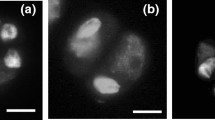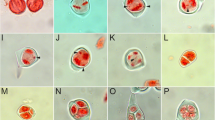Abstract
Selective megaspore abortion (monomegaspory) probably arose once in seed plants and occurs routinely in more than 70% of angiosperm species, representing one of the key characters of a heterosporous life history. In contrast, selective microspore abortion leading to pollen dispersal as pseudomonads (here termed monomicrospory) apparently arose at least twice independently within angiosperms, though it occurs in a limited number of taxa. Remarkably, similar examples of monomicrospory occur in members of two distantly related angiosperm families: the sedge family (Cyperaceae) and the epacrid subfamily (Styphelioideae) of the eudicot family Ericaceae. In sedges, monomicrospory is derived directly from normal tetrads, whereas epacrid pseudomonads apparently evolved via an intermediate stage, in which variable sterility occurs in a single tetrad. Our comparison of these two examples of selective microspore abortion highlights a correlation with aneuploidy, indicating that non-random chromosome segregation caused by monomicrospory could drive chromosomal mutations to rapid fixation through meiotic drive.


Similar content being viewed by others
References
Avise JC (1994) Molecular markers, natural history and evolution. Chapman and Hall, London
Bajon C, Horlow C, Motamayor JC, Sauvanet A, Robert D (1999) Megasporogenesis in Arabidopsis thaliana L.: an ultrastructural study. Sex Plant Reprod 12:99–109
Bateman RM, DiMichele WA (1994) Heterospory: the most iterative key innovation in the evolutionary history of the plant kindom. Biol Rev 69:345–417
Bateman RM, DiMichele WA (2002) Generating and filtering major phenotypic novelties: neoGoldschmidtian saltation revisited. In: Cronk QCB, Bateman RM, Hawkins JA (eds) Developmental genetics and plant evolution. Taylor and Francis, London, pp 109–159
Bednara J, van Lammeren AAM, Willemse MTM (1988) Microtubular configurations during meiosis and megasporogenesis in Gasteria verrucosa and Chamaenerion angustifolium. Sex Plant Reprod 1:164–172
Bell PR (1985) Maturation of the megaspore in Marsilea vestita. Proc Roy Soc Lond Ser B 223:485–494
Bell PR (1996) Megaspore abortion: a consequence of selective apoptosis? Int J Plant Sci 157:1–7
Bir SS, Cheema P, Kumari S, Sidhu M (1993) Occurrence of B-chromosomes and karyotypic analysis in sedge genus Eleocharis R.Br. Curr Sci 64:322–325
Blackmore S, Crane P (1988) The systematic implications of pollen and spore ontogeny. In: Humphries CJ (ed) Ontogeny and systematics. Columbia University Press, New York, pp 83–115
Brown RC, Lemmon BE (1996) Nuclear cytoplasmic domains, microtubules and organelles in microsporocytes of the slipper orchid Cypripedium californicum A. Gray dividing by simultaneous microsporogenesis. Sex Plant Reprod 9:145–152
Brown RC, Lemmon BE (2000) The cytoskeleton and polarization during pollen development in Carex blanda (Cyperaceae). Am J Bot 87:1–11
Copenhaver GP (2005) A compendium of plant species producing pollen tetrads. J North Carolina Acad Sci 121:17–35
Crayn DM, Quinn CJ (2000) The evolution of the atpβ-rbcL intergeneric spacer in the epacrids (Ericales) and its systematic and evolutionary implications. Mol Phylogenet Evol 16:238–252
Crayn DM, Kron KA, Gadek PA, Quinn CJ (1998) Phylogenetics and evolution of epacrids: a molecular analysis using the plastid gene rbcL with a reappraisal of the position of Lebetanthus. Aust J Bot 46:187–200
Davies EW (1956) Cytology, evolution and the origin of the aneuploid series in the genus Carex. Hereditas 42:349–365
Di Laurenzio L, Wysocka Diller J, Malamy JE, Pysh L, Helariutta Y, Freshour G, Hahn MG, Feldmann KA, Benfey PN (1996) The SCARECROW gene regulates an asymmetric cell division that is essential for generating the radial organization of the Arabidopsis root. Cell 86:423–433
Dolan L (1997) SCARECROW: specifying asymmetric cell divisions throughout development. Trends Plant Sci 2:1–2
Eady C, Lindsey K, Twell D (1995) The significance of microspore division and division symmetry for vegetative cell-specific transcription and generative cell differentiation. Plant Cell 7:65–74
Faulkner JS (1972) Chromosome studies on Carex section Acutae in north-west Europe. Bot J Linn Soc 65:271–301
Ford JH (1971) Ultrastructural and chemical studies of pollen wall development in Epacridaceae. In: Brooks J, Grant PR, Muir M, van Gijzel P, Shaw G (eds) Sporopollenin. Academic Press, London, pp 130–173
Francis KE, Lam SY, Copenhaver GP (2006) Separation of Arabidopsis tetrads is regulated by QUARTET1, a pectin methylesterase gene. Plant Physiol 142:1004–1013
Furness CA (2009) Pollen evolution and development in Ericaceae, with particular reference to pseudomonads and variable pollen sterility in Styphelioideae. Int J Plant Sci 170:476–495
Furness CA, Rudall PJ (1999) Microsporogenesis in monocotyledons. Ann Bot 84:475–499
Goetghebeur P (1998) Cyperaceae. In: Kubitzki K (ed) The families and genera of vascular plants, vol 4. Springer-Verlag, Berlin, pp 141–190
Grant V (1981) Plant speciation. Columbia University Press, New York
Håkansson A (1958) Holocentric chromosomes in Eleocharis. Hereditas 44:531–540
Hipp AL (2007) Nonuniform processes of chromosome evolution in sedges (Carex: Cyperaceae). Evolution 61:2175–2194
Ikeshima-Kataoka H, Skeath JB, Nebeshima Y, Doe CQ, Matsuzaki F (1997) Miranda directs Prospero to a daughter cell during Drosophila asymmetric divisions. Nature 390:625–629
Jablonka E, Lamb ML (1995) Epigenetic inheritance and evolution. Oxford University Press, Oxford
Jan YN, Jan LY (1998) Asymmetric cell division. Nature 392:775–778
Keighery GJ (1996) Phytogeography, biology and conservation of Western Australian Epacridaceae. Ann Bot 77:347–355
King RW, Deshaies RJ, Peters JM, Kirschner MW (1996) How proteolysis drives the cell cycle. Science 274:1652–1659
Kirpes CC, Clark LG, Lersten NR (1996) Systematic significance of pollen arrangement in microsporoangia of Poaceae and Cyperaceae: review and observations on representative taxa. Am J Bot 83:1609–1622
Knox RB, Friederich E (1974) Tetrad pollen grain development and sterility in Leschenaultia formosa (Goodeniaceae). New Phytol 73:251–258
Kovarik A, Werlemark G, Leitch AR, Souckova-Skalicka K, Lim YK, Khaitova L, Koukalova B, Nybom H (2008) The asymmetric meiosis in pentaploid dogroses (Rosa sect. Caninae) is associated with a skewed distribution of rRNA gene families in the gametes. Heredity 101:359–367
Kron KA, Judd WS, Stevens PF, Crayn DM, Anderberg AA, Gadek PA, Quinn CJ, Luteyn JL (2002) Phylogenetic classification of Ericaceae: molecular and morphological evidence. Bot Rev 68:335–423
Linder HP, Rudall PJ (2005) The evolutionary history of Poales. Ann Rev Ecol Evol Syst 36:107–124
Luceño M (1993) Chromosome studies on Carex L. section Mitratae Kükenth. (Cyperaceae) in the Iberian Peninsula. Cytologia 58:321–330
Malheiros-Garde N, de Castro D (1947) Chromosome number and behaviour in Luzula purpurea Link. Nature 160:156
Martin HA (1993) Monotoca-type (Epacridaceae) pollen in the Late Tertiary of southern Australia. Aust J Bot 41:709–720
Martin PG, Peacock WJ (1959) Pollen tetrad patterns in Leschenaultia. Proc Linn Soc N S Wales 84:271–277
Naczi RFC, Reznicek AA, Ford BA (1998) Morphological, geographical, and ecological differentiation in the Carex willdenowii complex (Cyperaceae). Am J Bot 85:434–447
Oh S-A, Bourdon V, Das ‘Pal M, Dickinson H, Twell D (2008) Arabidopsis kinesins HINKEL and TETRASPORE act redundantly to control cell plate expansion during cytokinesis in the male gametophyte. Mol Plant 1:794–799
Pagnussat GC, Yu H-J, Ngo QA, Rajani S, Mayalagu S, Johnson CS, Capron A, Xie L-F, Ye D, Sundaresan V (2005) Genetic and molecular identification of genes required for female gametophyte development and function in Arabidopsis. Development 132:603–614
Pardo-Manuel de Villena F, Sapienza C (2001) Female meiosis drives karyotypic evolution in mammals. Genetics 159:1179–1189
Peacock WJ (1963) Chromosome numbers and cytoevolution in the Goodeniaceae. Proc Linn Soc N S Wales 138:8–27
Pennell RI, Lamb C (1997) Programmed cell death in plants. Plant Cell 9:1157–1168
Pettitt JM (1971) Developmental mechanisms in heterospory, I. Megasporocyte degeneration in Selaginella. Bot J Linn Soc 64:237–246
Preuss D, Rhee SY, Davis RW (1994) Tetrad analysis is possible in Arabidopsis with mutation of the Quartet (QRT) genes. Science 264:1458–1460
Qiu YL, Liu RS, Xie CT, Russell SD, Tian HQ (2008) Calcium changes during megasporogenesis and megaspore degeneration in lettuce (Lactuca sativa L.). Sex Plant Reprod 21:197–204
Quinn CJ, Crayn DM, Heslewood MM, Brown EA, Gadek PA (2003) A molecular estimate of the phylogeny of Styphelieae (Ericaceae). Aust Syst Bot 16:581–594
Quinn CJ, Brown EA, Heslewood MM, Crayn DM (2005) Generic concepts in Styphelieae (Ericaceae): the Cyathodes group. Aust Syst Bot 18:439–454
Ranganath RM (2005) Asymmetric cell divisions in flowering plants–one mother, “two-many” daughters. Plant Biol 7:425–448
Ranganath RM, Rao Nagashree N (2000) Selective cell elimination in sedges. Sex Plant Reprod 13:53–60
Reznicek AA (1990) Evolution in sedges (Carex, Cyperaceae). Can J Bot 68:1409–1432
Rhee SY, Osborne E, Poindexter PD, Somerville CR (2003) Microspore separation in the quartet 3 mutants of Arabidopsis is impaired by a defect in a developmentally regulated polygalacturonase required for pollen mother cell wall degradation. Plant Physiol 133:1170–1180
Roalson EH, McCubbin AG, Whitkus R (2007) Chromosome evolution in Cyperales. In: Columbus JT, Friar EA, Porter JM, Prince LM, Simpson MG (eds) Monocots: comparative biology and evolution–Poales, Aliso vol 23. Rancho Santa Ana Botanic Garden, Claremont, California, pp 62–71
Rothrock PE, Reznicek AA (2001) The taxonomy of the Carex bicknellii group (Cyperaceae) and new species for Central North America. Novon 11:205–228
Rudall PJ, Bateman RM (2007) Developmental bases for key innovations in the seed-plant microgametophyte. Trends Plant Sci 12:317–326
Sarwar AKMG, Takahashi H (2006) The taxonomic significance of pollen morphology in Andromedeae s.s., Gaultherieae, Lyonieae and Oxydendreae (Ericaceae: Vaccinioideae). Jap J Palynol 52:77–96
Sarwar AKMG, Ito T, Takahashi H (2006) An overview of pollen morphology and its relevance to the sectional classification of Vaccinium L. (Ericaceae). Jap J Palynol 52:15–34
Shen CP, Jan LY, Jan YN (1997) Miranda is required for the asymmetric localization of Prospero during mitosis in Drosophila. Cell 90:449–458
Simpson DA, Furness CA, Hodkinson TR, Muthama Muasya A, Chase MW (2003) Phylogenetic relationships in Cyperaceae subfamily Mapanioideae inferred from pollen and plastid DNA sequence data. Am J Bot 90:1071–1086
Smith-White S (1955) Chromosome numbers and pollen types in the Epacridaceae. Aust J Bot 3:48–67
Smith-White S (1959) Pollen development patterns in the Epacridaceae. A problem in cytoplasm-nucleus interaction. Proc Linn Soc N S Wales 84:8–35
Stace HM, Chapman AR, Lemson KL, Powell JM (1997) Cytoevolution, phylogeny and taxonomy in Epacridaceae. Ann Bot 79:283–290
Taaffe G, Brown EA, Crayn DM, Gadek PA, Quinn CJ (2001) Generic concepts in Styphelieae: resolving the limits of Leucopogon. Aust J Bot 49:107–120
Tanaka I (1997) Differentiation of generative and vegetative cells in angiosperm pollen. Sex Plant Reprod 10:1–7
Twell D et al (1998) Asymmetric division and cell-fate determination in developing pollen. Trends Plant Sci 3:305–310
van Doorn W, Woltering EJ (2005) Many ways to exit? Cell death categories in plants. Trends Plant Sci 10:117–122
Webb MC, Gunning BES (1990) Embryo sac development in Arabidopsis thaliana. 1. Megasporogenesis, including the microtubular cytskeleton. Sex Plant Reprod 3:244–256
Williams JH, Friedman WE (2004) The four-celled female gametophyte of Illicium (Illiciaceae; Austrobaileyales): implications for understanding the origin and early evolution of monocots, eumagnoliids, and eudicots. Am J Bot 91:332–351
Woodcock CLF, Bell PR (1968) Features of the ultrastructure of the female gametophyte of Myosurus minimus. J Ultrastruct Res 22:456–563
Wright H, van Doorn WG, Gunawardena AHLAN (2009) In vivo study of developmental programmed cell death using the lace plant (Aponogeton madagascariensis; Aponogetonaceae) leaf model system. Am J Bot 96:865–876
Wu H-M, Cheung AY (2000) Programmed cell death in plant reproduction. Plant Mol Biol 44:267–281
Acknowledgments
We thank Richard Bateman and Ralf Kynast for critically reading the manuscript and two anonymous reviewers for their comments.
Conflict of interest
The authors declare that they do not have any conflict of interest.
Author information
Authors and Affiliations
Corresponding author
Additional information
Communicated by Hugh Dickinson.
Rights and permissions
About this article
Cite this article
Furness, C.A., Rudall, P.J. Selective microspore abortion correlated with aneuploidy: an indication of meiotic drive. Sex Plant Reprod 24, 1–8 (2011). https://doi.org/10.1007/s00497-010-0150-z
Received:
Accepted:
Published:
Issue Date:
DOI: https://doi.org/10.1007/s00497-010-0150-z




